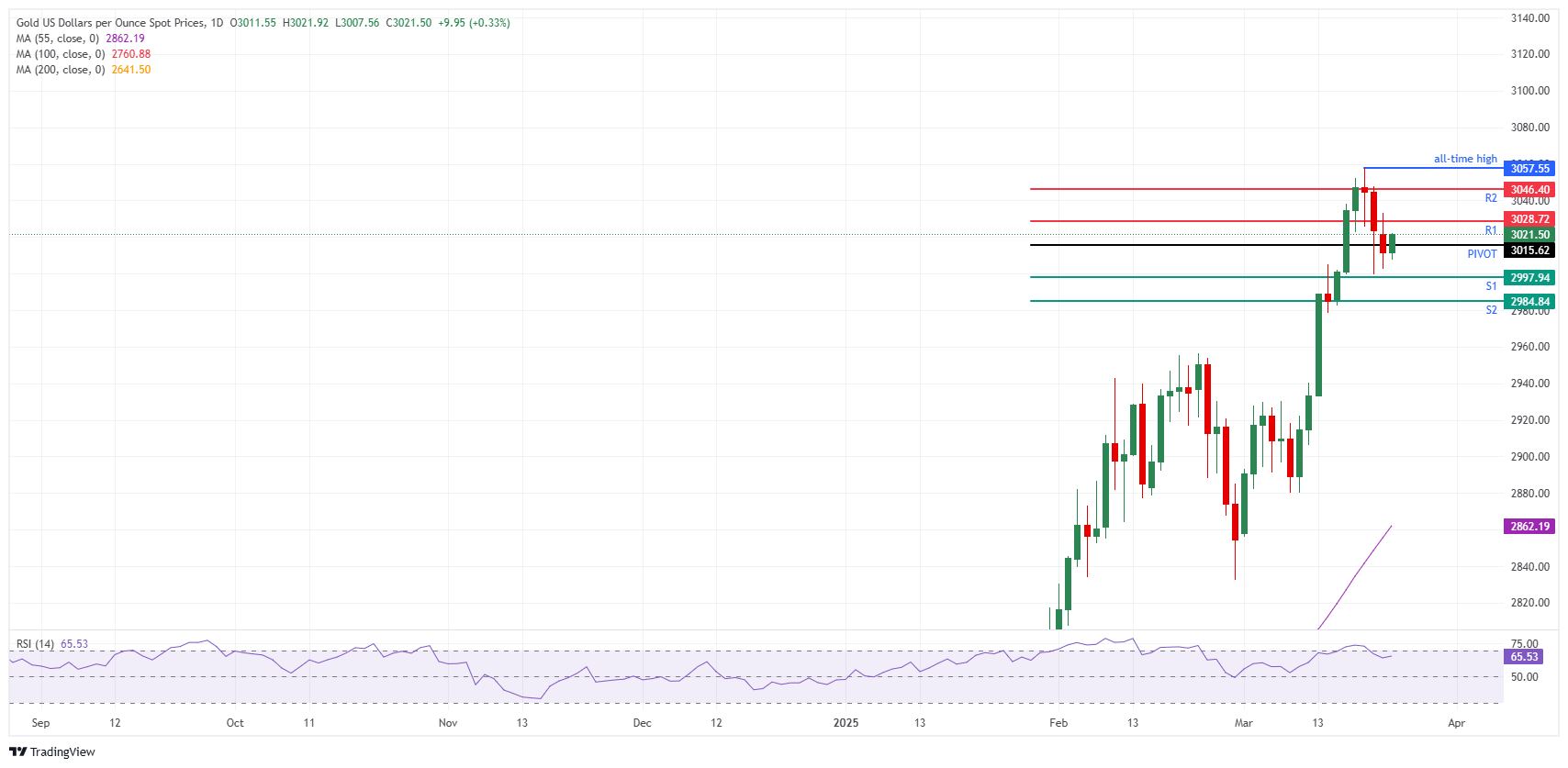- Gold was able to maintain ground above $3,000 on Monday after a recent decline from all-time highs.
- US President Trump issued more comments and will impose more tariffs on cars and against countries buying Venezuelan Oil.
- Gold is still supported in the $3,000 region, though a higher breakout is needed to avoid persisent selling pressure on the topside.
Gold’s price (XAU/USD) stabilises near $3,025 at the time of writing on Tuesday while markets are mulling tariff headlines from United States (US) President Donald Trump. The president issued an executive order on Monday to impose “secondary tariffs” of 25% on all imports from those countries buying Oil from Venezuela, which would mean a sharp rise in levies on goods from China and India.
On Monday, Trump said reciprocal tariffs will be eased off for countries meeting US requests on reshoring their businesses and factories. He went further and said tariffs on cars, aluminum and pharmaceuticals will be issued in the very near future. Trump also added that lumber and chips could be a potential tariff target as well.
Daily digest market movers: Secondary tariffs a new thing
- Gold is finally drawing decent volumes into bullion-backed Exchange Traded Funds (ETFs), in what has been one of the more interesting developments in commodities in the near end of the first quarter of 2025. If sustained, it augurs well for prices in the second quarter of the year, Bloomberg reports.
- In the takeover story between Australia’s Gold Road Resources and South Africa’s Gold Fields, Gold Road Resources chief executive Duncan Gibbs says a $3.3 billion takeover bid from Gold Fields is too low, describing the proposal from the Johannesburg-listed miner as extremely aggressive and hostile, Reuters reports.
- A proposal from the Trump administration to impose levies on Chinese-made ships entering US ports is sowing panic in the US agriculture industry, with farmers saying the added cost threatens to upend exports of wheat, corn and soyabeans, the Financial Times reports.
- Trump has come up with a new weapon of economic statecraft on Monday after threatening with “secondary tariffs” on countries that buy Oil from Venezuela to choke off its oil trade with other nations. This was triggering additional tariff concerns with markets seeing this as a secondary way to impose still vast amounts of tariffs without making them reciprocal, Bloomberg reports.
Technical Analysis: Not onvincing enough
The bounce is getting underway this Tuesday after US President Trump’s comments about issuing ‘secondary’ tariffs. His administration is looking to ease off the reciprocal approach. This will make the entire assessment of levies and how to quantify them even more difficult.
On the upside, the daily R1 resistance comes in at $3,028. Further up, the R2 resistance at $3,046 coincides with Friday’s high and the R1 resistance from Monday. This means that this level is a heavy barrier before pointing to the current all-time high at $3,057.
On the downside, some red flags remain as the intraday S1 support stands at $2,997. That means the $3,000 mark is exposed and needs to act on its own as big support. There is no line of defense before to make sure any downturn is being slowed. Further down, the S2 support comes in at $2,984.
XAU/USD: Daily Chart
US-China Trade War FAQs
Generally speaking, a trade war is an economic conflict between two or more countries due to extreme protectionism on one end. It implies the creation of trade barriers, such as tariffs, which result in counter-barriers, escalating import costs, and hence the cost of living.
An economic conflict between the United States (US) and China began early in 2018, when President Donald Trump set trade barriers on China, claiming unfair commercial practices and intellectual property theft from the Asian giant. China took retaliatory action, imposing tariffs on multiple US goods, such as automobiles and soybeans. Tensions escalated until the two countries signed the US-China Phase One trade deal in January 2020. The agreement required structural reforms and other changes to China’s economic and trade regime and pretended to restore stability and trust between the two nations. However, the Coronavirus pandemic took the focus out of the conflict. Yet, it is worth mentioning that President Joe Biden, who took office after Trump, kept tariffs in place and even added some additional levies.
The return of Donald Trump to the White House as the 47th US President has sparked a fresh wave of tensions between the two countries. During the 2024 election campaign, Trump pledged to impose 60% tariffs on China once he returned to office, which he did on January 20, 2025. With Trump back, the US-China trade war is meant to resume where it was left, with tit-for-tat policies affecting the global economic landscape amid disruptions in global supply chains, resulting in a reduction in spending, particularly investment, and directly feeding into the Consumer Price Index inflation.


